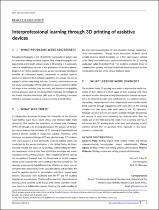| dc.contributor.author | Filies, Gérard C | |
| dc.contributor.author | Ingram, Chinno | |
| dc.contributor.author | Mthembu, Thuli M. | |
| dc.date.accessioned | 2023-05-17T10:37:20Z | |
| dc.date.available | 2023-05-17T10:37:20Z | |
| dc.date.issued | 2023 | |
| dc.identifier.citation | Filies, G. C. et al. (2023). Interprofessional learning through 3D printing of assistive devices. https://doi.org/10.1111/medu.15105 | en_US |
| dc.identifier.issn | 1365-2923 | |
| dc.identifier.uri | https://doi.org/10.1111/medu.15112 | |
| dc.identifier.uri | http://hdl.handle.net/10566/8919 | |
| dc.description.abstract | Emerging technologies in the rehabilitative component of patient care
in community settings continue to grow. One of the emerging technological
fields in the health sciences arena is 3D printing. It is particularly
useful in rehabilitation services in the production of assistive devices.
Degerli et al.1 define assistive devices, as any commercially developed,
modified or customised system, component or product used to
improve or preserve the functional capabilities of a person not able to
engage in all their daily living activities. Currently, assistive devices are
not easily customizable. Off-the-shelf devices do not meet the individual
needs of the customer; they are costly, lack individual compatibility
and not always in stock. In minimising these challenges, technologies of
the Fourth Industrial Revolution (4IR) such as 3D printing have been
offered as a practical solution at a local university in South Africa. | en_US |
| dc.language.iso | en | en_US |
| dc.publisher | Wiley | en_US |
| dc.subject | Information Technology Communication | en_US |
| dc.subject | Fourth Industrial Revolution | en_US |
| dc.subject | Teaching and Learning | en_US |
| dc.subject | University of the Western Cape | en_US |
| dc.subject | Health science | en_US |
| dc.title | Interprofessional learning through 3D printing of assistive devices | en_US |
| dc.type | Article | en_US |

